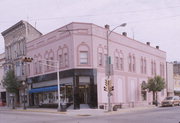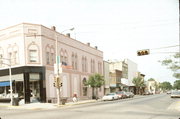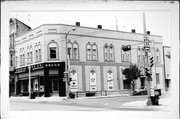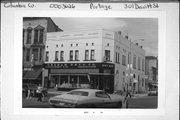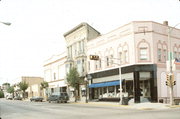Property Record
301 DEWITT ST
Architecture and History Inventory
| Historic Name: | GRAHAM DRUG CO. |
|---|---|
| Other Name: | GINGHAM GOOSE |
| Contributing: | Yes |
| Reference Number: | 3626 |
| Location (Address): | 301 DEWITT ST |
|---|---|
| County: | Columbia |
| City: | Portage |
| Township/Village: | |
| Unincorporated Community: | |
| Town: | |
| Range: | |
| Direction: | |
| Section: | |
| Quarter Section: | |
| Quarter/Quarter Section: |
| Year Built: | 1873 |
|---|---|
| Additions: | |
| Survey Date: | 1992 |
| Historic Use: | large retail building |
| Architectural Style: | Italianate |
| Structural System: | Brick |
| Wall Material: | Cream Brick |
| Architect: | |
| Other Buildings On Site: | |
| Demolished?: | No |
| Demolished Date: |
| National/State Register Listing Name: | Portage Retail Historic District |
|---|---|
| National Register Listing Date: | 4/27/1995 |
| State Register Listing Date: | 10/24/1994 |
| National Register Multiple Property Name: |
| Additional Information: | A 'site file' exists for this property. It contains additional information such as correspondence, newspaper clippings, or historical information. It is a public record and may be viewed in person at the State Historical Society, Division of Historic Preservation. Canted entrance; parapet with brick panels and belt course; double windows with round arch lintels and keystone. Mortar and pestle symbol; elevation divided into panels with pelanie and corbeling; west elevation covered with canara glass. glass block transom; recessed, canted entry. some windows closed oak post and beam support. In 1853, John A. Graham and William K. Miles clerked at the drug and grocery store of Samuel Edwards who established his business in that year in the Pettibone block. After Edward's retirement from the business in 1856, Miles and Graham continued the drug company under the name of Miles & Company. Miles and Company occupied the Vandercook Block at 236 W. Wisconsin (24/32) by at least 1865 to 1867 (Portage Public Library n.d. [photo]; Columbia Co. Treasurer 1863- [1863-73]). At the death of Miles in 1867, John graham acquired the company and maintained the business at 236 W. Wisconsin. In 1867-1868, John Graham advertised as a (Farnham and Vivian 1867068): ... Wholesale and Retail Druggist and Grocer. Dealer in ] Stationery, Yankee Notions, Fine Liquors, cutlery, Wall Paper and Crockery, Paints, Oils, Varnishes, Water Lime, Land Plaster, Builders' and Painter's Materials. Garden and Field Seed, Window Glass and Glassware. Agents for Mail, Steamship and Sail Vessels to all parts of the world. In 1873, Graham completed his two story and basement, wood post and beam, brick block at 301 DeWitt (Harrison and Warner 1873 [date block[} (25/17). Serving as the agent for the Anchor, Cunard, White Star, Inman, and State Line Steam Ship companies, maintained a Minnesota Paint dealership, and continued his broad line of goods such as wall paper, stationery, books, varnishes, tar, picture frames, glassware, shades, and engravings through the nineteenth century. Graham also printed a small, tabloid known as the Graham Quarterly Review between 1861 to 1872. John A. Graham, Jr. joined his father in 1895. John Graham, Sr. incorporated the business as the John Graham Drug Company to conduct a mercantile business and manufacture and sell medicines before hi s death in 1916. After his death, his son operated the store under a lease from the drug company. J.C. Stegman and Bryon Taylor purchased the company and building from John Graham, Jr. in 1926. Clinton Daugherty and B.Y. Taylor acquired the drug store in 1962. Daugherty bought Taylor's interest in the story in 1969 and the building from Mrs. Norman Stegman Brenner in 1981. By 1883, the Graham Block also included the offices of physicians William Meacher who began practice in 1870 and William and Stuart Taylor on the second floor until about 1952 (see below). Graham also rented space to the Portage Loan Trust Company between ca. 1905 and 1908 (Jones 1914[1]: 202; Daugherty 1898-1992) and the Singer Sewing Machine Company in 1908. The basement provided storage space for the large stock carried by early merchants ordering their goods only several times a year. A barber shop with entrance on Cook Street also occupied a small room in the basement about 1908-1918. William Windus occupied this location as barber in 1908-09. The Graham Block received a new front which included the entrance along the DeWitt Street elevation in 1953. The interior remodeling of the store in 1965 included the removal of the soda fountain from the northwest corner of the building. The carbonator remained in the basement at the sale of the building in 1991 (River Times 1853 [8/15: 2/3]; Wisconsin State Register 6/13/74; Farnham and Vivian 1867-68; Jones 1914 [2]: 631-32; Portage Daily Register 12/23/1889; 1908 [2/8: 3/6]; 7/21/73; 8/23/1969 Register-Democrat 10/271953; Democrat 7/30/97; Hotchkiss 1913; Columbia County Historical Society 1982; Graham 1875; Daughtery 1898-1992). Dr. William Meacher began his medical practice at Portage in 1870. He received medical training at Rush Medical College in Chicago. A member of the State Medical Society of Wisconsin, Dr. Meacher served as its president in 18812 and 1882. He also became Portage's health officer. Dr. Bryon Meacher continued William Meacher's practice after his death in 1989. He joined his father's practice in 1883. Buyron Meacher gained his medical degree at Rush Medical College and continued his training as an intern at Cook County Hospital. He also specialized in surgery and was a member of the State Medical Society. Between 1906 and 1913, he with Dr. A.M. Bellack of Columbia maintained a small hospital in Columbus. By ca. 1914, Dr. Meacher assisted the Sisters of Divine Savior with their fund drive in support of the Divine Savior Hospital in Portage. After the hospital opened in 1917, Dr. Meacher became its chief of staff until 1937. In 1919 Dr. William Taylor, also a graduate of Rush Medical College joined Dr. Bryon Meacher's practice. They continued the practice until Meacher's death in 1938. Taylor maintained a practice until 1976. By 1883, the Meachers and later his nephew Dr. William Taylor and Dr. William Taylor, and Dr. Stewart Taylor who joined the practice in 1948 maintained offices on the second floor of Graham's Drugstore (301 DeWitt, 25/17). The office remained at this location until the construction of the Taylor Clinic (108 E. Cook, 57/32) in 1957 (Portage Daily Register 8/23/1969; 2/8/81; Portage Public Library n.d [photograph]; corner stone, 108 E. Cook; Turner, A.J. 1903: 26-27; Jones 1914 [2] 736-38; American Biographical Publishing Co. 1877: 138-39; State Medical Society of Wisconsin, n.d.). |
|---|---|
| Bibliographic References: | PORTAGE 1989 LANDMARKS CALENDAR. 1929: drugs, post and beam construction. 1918: drugs, books, and stationery; barber in basement 1910: same 1901: Drugs, books, stationery, and wall paper 1894: Graham block: Drugs, books, stationery, and wall paper first and doctor's offices second 1889: Graham block: drugs, stationery, wall paper and books first; doctor's offices and printing second Columbia Co. Treasurer 1863- 1880-1930: John Graham 1874: Jno. Graham, value 75001873: Jno Grahan, value 2800 1871: Mary Miles: 3000 (different building) 1868: Verandah Block, different building (Rugen) 1878: date on cast iron cornice reads 1873 (Harrison and Warner) The Graham Blocki was erected in 1873 and replaced the Verandah Block which was constructed in 1856 (Butterfield 1880: 590; Turner, A.J. 1903; 15-16). McCarthy 1962 (2/10) 1962: J.C. Stegmen and Bryon Taylor sold to Clinton Daugherty 1926: John A. Grahan to J.C. Stegman and Bryon Taylor Directory 1908-09: William Windus, the bawrber was in the basement (S.H. Moore) Historic Portage, WI: Downtown & Waterfront Walking Tour, 1995. |
| Wisconsin Architecture and History Inventory, State Historic Preservation Office, Wisconsin Historical Society, Madison, Wisconsin |

